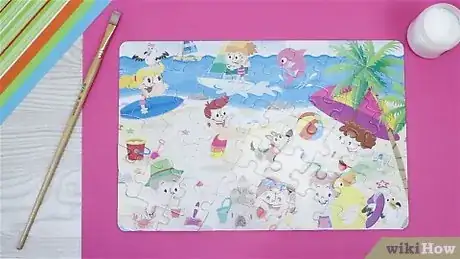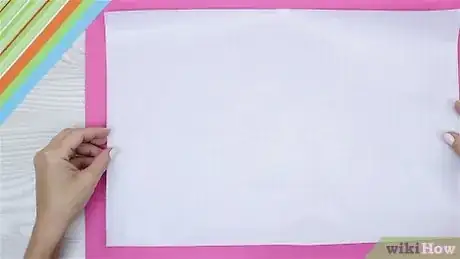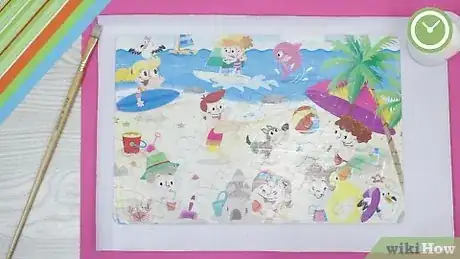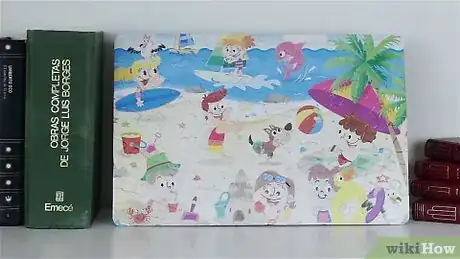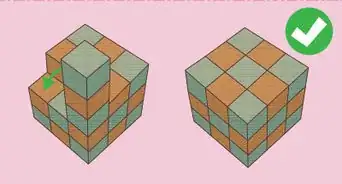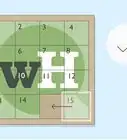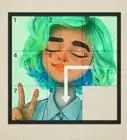This article was co-authored by Amy Guerrero. Amy Guerrero is an Arts and Crafts Specialist and the Owner of Sunshine Craft Co., a crafting studio based in Phoenix, Arizona. Amy specializes in macrame, DIY crafting, and teaching fiber arts. She offers monthly in-person and online workshops along with having developed a range of DIY craft kits for at-home projects. Amy holds a BS in Industrial Design from Philadelphia University. She worked as a graphic designer before starting her own business. Sunshine Craft Co. is a creative hub that offers a wide range of workshops, tools, and resources for any craft project to inspire creativity and community engagement.
wikiHow marks an article as reader-approved once it receives enough positive feedback. In this case, 91% of readers who voted found the article helpful, earning it our reader-approved status.
This article has been viewed 303,979 times.
Many puzzles, when finished, are truly works of art. After completing your puzzle, you may want to preserve it so you can share the finished product with your friends and enjoy looking at your achievement down the road. You can do this by spreading a clear adhesive over the front of the puzzle to join all the pieces together, and you can further stabilize your puzzle by gluing the back as well. Once the gluing is done, you can even mount your puzzle to a firm surface so that all the pieces stay firmly in place.
Steps
Gluing the Front of your Puzzle
-
1Acquire your materials. To ensure the glue you use doesn't cloud the surface of your puzzle, flake, or cause damage, you should use specially intended puzzle glue for gluing your puzzle. This can be bought at most craft and hobby stores. In all, for this project you'll need:
- Puzzle glue
- Paintbrush (or sponge)
- Parchment paper (or wax paper)
- Any clear adhesive, like shellac or decoupage glue, can be used to glue your puzzle together, though some glues might leave a cloudy finish or not glue as firmly as puzzle glue.[1]
-
2Lay out parchment paper over your work area. You'll want to work on a level, clear space while gluing your puzzle. Sometimes, glue can seep between puzzle pieces, causing the pieces to stick to your work surface. To prevent this, you should put a layer of parchment paper between your puzzle and the surface on which you're working.[2]
- The parchment paper you lay beneath your puzzle should extend several inches beyond its outer edges.
- If you don't have parchment paper handy, you could also use wax paper to prevent puzzle pieces from sticking to your work surface.
Advertisement -
3Position your puzzle on the parchment paper. If you are able, slide your puzzle over the top of your parchment paper. If this is not possible, you may need to get a thin, stiff piece of card stock to slide underneath your puzzle to help you transfer it to the parchment paper.
- At this point, your puzzle should be facing picture side up atop your parchment (or wax) paper, and your paper should extend a few inches beyond the outer edges of the puzzle.[3]
- Make sure that the surface is completely dry before you start applying any glue.
-
4Add glue to the center of your puzzle. To ensure an even layer of glue is spread over your puzzle, you should start at the center of the puzzle and work your way to its outer edges. Start with a moderate amount of glue first. You can always add more later, if necessary.
- Working from the center of the puzzle out will also help prevent you from using too much glue, which can cause unevenness in the glue.[4]
- Try to use the minimal amount of glue that you need for your project. This will help the glue dry faster.
-
5Spread the glue evenly over your puzzle. Add your glue a little bit at a time and use your paintbrush or sponge to spread your glue from the center to the outer corners of your puzzle. You should only need a thin layer of glue to hold the puzzle pieces together.
- Adding too much glue to your puzzle can sometimes cause the pieces to curl when the glue is dried.[5]
- Some brands of puzzle glue come with a plastic glue spreader that you can use to distribute your glue over the surface of your puzzle.
- If you find that a brush or a sponge doesn't work well for spreading glue and if your puzzle glue did not come with a spreader, you may be able to use a plastic spatula to distribute the glue more quickly. However, dried glue can be difficult to remove from your spatula once you are finished.
-
6Remove any globs of glue from the puzzle. In many cases, when you reach the edges of your puzzle, you'll find that you have some excess glue. Remove this by pushing it off the edges onto the parchment paper with your paintbrush, sponge, or plastic spreader.[6]
- If you are using a plastic spreader/spatula, you may be able to remove extra glue by scooping it up and wiping it onto a piece of paper towel.
-
7Allow the glue to dry. Depending your the brand of puzzle glue you have bought, this may only take a few hours or may require an entire night to dry. When waiting for your puzzle to dry, it's best to err on the side of caution. Moving your puzzle too soon can cause wet glue to deform the puzzle pieces.
- You should check the label instructions for your glue to determine the amount of time your glue needs to dry.[7]
- Using a fan, hair dryer, or heat gun can help the glue dry faster.
Gluing the Back for Added Stability
-
1Flip your puzzle. The bond created by your glue on the front of your puzzle should allow you to easily pick up the puzzle by hand and turn it so the cardboard side of the puzzle is facing up. Larger puzzles can sometimes be more unstable. In this case, you might want to use a piece of cardboard or stiff card stock under the puzzle to provide stability while flipping.[8]
- Glue can often seep between the spaces between puzzle pieces. When this happens, gently peel the puzzle free of the wax paper before flipping it.
- For especially stubborn glue, you might need to use a firm plastic edge, like a spatula, to break the bond between the puzzle and the parchment paper. Use firm but gentle pressure when doing this.
- After you flip your puzzle, you should reinsert parchment paper beneath it to prevent glue from sticking pieces to your work surface.
-
2Glue your puzzle from the center out. Add a moderate amount of glue to the center of your puzzle and spread a thin layer toward the edges using your paint brush or sponge. Much like when gluing the front of your puzzle, you should aim for a thin, even coat of glue.[9]
- You should add glue to your puzzle a little bit at a time to prevent wasting glue and to ensure a thin, even coating over the pieces.
-
3Push excess glue off the edges of the puzzle. Once you reach the outer edges of your puzzle, you'll likely have some extra glue left over. Use your paintbrush or sponge to push this glue off the edges of the puzzle and onto the parchment paper.[10]
-
4Allow the glue to fully dry. Once the glue on the back of your puzzle is fully dry, your puzzle should be firmly connected together. In many cases, this will be stable enough that you won't have to worry about framing or mounting your puzzle if displaying it on a flat surface. However, framing or mounting your puzzle can provide even more stability to puzzles you plan to hang.[11]
Mounting your Puzzle
-
1Avoid hanging a puzzle without mounting. Over time, the glue of your puzzle will deteriorate naturally. This can cause pieces to come loose and become lost. To ensure your puzzle stays in one piece, you should mount or frame it when hanging.[12]
-
2Move your puzzle with care. If you are planning on moving your puzzle to a different location, make a folder from two pieces of corrugated cardboard, available at any picture frame shop.
- Tape the pieces together to make a folder.
- Slide the glued puzzle onto a piece of corrugated cardboard for stability.
- The puzzle can be moved safely with a folder. If the puzzle is bent, the glue can crack or cause the puzzle to warp. A rigid backing will prevent this from happening.
-
3Use a simple cardboard mount if you do not plan to put your puzzle in a frame. With a piece of plain cardboard that is larger than your puzzle, you can make an effective mount.
- Simply take your puzzle glue and apply a moderate amount to the back of your puzzle.
- Lay your glued puzzle onto the cardboard.
- Allow the glue to dry. Then take a utility knife and cut the excess cardboard free from your puzzle. Do this by cutting with your utility knife around the border of the puzzle.
-
4Go with a more elaborate mount if you plan to frame your puzzle. Choose the frame before mounting! A sturdy, relatively thin foam board is often attached to the back of puzzles before framing. Foam board will have more flex than other kinds of mounting material. This can make your puzzle easier to insert into a frame.
- There are many kinds of foam board you might use to mount your puzzle. These are often available at hobby stores, craft stores, or picture framing stores.
- If you are unsure if the foam board you selected for mounting your puzzle is thin/sturdy enough, the service representative of your local hobby/craft store or picture framing store should be able to offer advice.[13]
-
5Adjust your puzzle size if needed.
- If you find a picture frame that is not exactly the same size as your puzzle, then the puzzle, if too big, will need to be cut down with a sharp utility knife. Start the cut by lightly scoring the top layer of the puzzle. Draw the knife in the same line several times until you have cut through the puzzle.
- If the puzzle is too small for the frame, you can choose a backing board that fits the frame and center the puzzle on it.
- If you want the frame to fit exactly, you may need to build a frame or find a picture framing shop to help you.
-
6Frame your puzzle. A frame can give your finished, glued puzzle the appearance of a work of art. First you'll need to measure your puzzle dimensions and purchase a frame that will fit it. Lay your puzzle inside the frame and seal the back of the frame to protect and showcase your puzzle.[14]
- Most frames come with catches or tabs at the back that can be used to either hold the puzzle in place or to sandwich the puzzle between the glass of the frame and a piece of cardboard.
- If you're trying to save money, you may be able to find a suitable, inexpensive frame at a secondhand store and re-purpose the frame for your puzzle. That is why you need to mount the puzzle after you have chosen the frame, so that you can make the backing board the right size to fit the frame. A picture framing store can cut a frame to the precise size you need.
Community Q&A
-
QuestionShould I glue the front or back of the puzzle?
 Community AnswerGluing one side of your puzzle will hold the pieces together, and gluing either front or back can work for this purposes. However, gluing both sides will provide the greatest stability and prevent pieces from coming loose.
Community AnswerGluing one side of your puzzle will hold the pieces together, and gluing either front or back can work for this purposes. However, gluing both sides will provide the greatest stability and prevent pieces from coming loose. -
QuestionIf I glue the puzzle face-down, won't glue seep through to the front?
 Community AnswerA little might, but if you use PVA glue or another type of clear glue it's unlikely it will be noticeable.
Community AnswerA little might, but if you use PVA glue or another type of clear glue it's unlikely it will be noticeable. -
QuestionIs it better to glue the front or the back of the puzzle?
 Community AnswerOne side isn't superior than the other, but gluing only one side can result in a slight curl to the pieces. This can be fixed by applying glue to both sides of the puzzle.
Community AnswerOne side isn't superior than the other, but gluing only one side can result in a slight curl to the pieces. This can be fixed by applying glue to both sides of the puzzle.
Things You'll Need
- Puzzle glue
- Sponge or brush
- Parchment paper (or wax paper)
References
- ↑ https://www.youtube.com/watch?v=MQd8NdPHsS8&feature=youtu.be
- ↑ https://snapguide.com/guides/glue-a-puzzle-together/
- ↑ https://myjigsawjournal.com/2019/10/12/how-to-glue-a-puzzle/
- ↑ https://www.youtube.com/watch?v=MQd8NdPHsS8&feature=youtu.be
- ↑ http://www.puzzlewarehouse.com/how-to-glue-a-puzzle/
- ↑ https://snapguide.com/guides/glue-a-puzzle-together/
- ↑ http://piecetimepuzzles.com/how-to-glue-puzzles/
- ↑ https://snapguide.com/guides/glue-a-puzzle-together/
- ↑ https://www.youtube.com/watch?v=MQd8NdPHsS8&feature=youtu.be
About This Article
If you’ve put together a puzzle and you want to preserve it, try gluing it so you can hang it like a picture. Lay the assembled puzzle on a sheet of parchment paper. Apply a moderate amount of puzzle glue or another clear adhesive to the center of the puzzle, then brush it outward with a craft brush. Add more glue as needed until you’ve glued the entire front surface. Let the glue dry completely, then turn the puzzle over and repeat the process on the back. Keep reading for tips on how to mount your puzzle to hang it!
